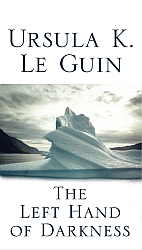American writer of science fiction and fantasy, poet and critical essays. Le Guin has examined large ethical, moral, and social issues in her work and her fame has extended beyond the genre boundaries. Her thought-provoking novels include
The Left Hand of Darkness (1969), which won both the Hugo and Nebula Awards, as did
The Dispossessed (1974). The celebrated Earthsea books, written for young adults, have been compared to C.S Lewis's Narnia chronicles and Tokien's
The Lord of the Rings.
Ursula K. Le Guin was born in Berkeley, California, the daughter of Dr Alfred and Theodora Kroeber Quinn. Le Guin's mother was a psychologist and writer of children's stories. Her father was the head of UC-Berkeley's Department of Anthropology, who published work on Native Americans. Le Guin grew up both in an academic atmosphere, but her summers she spent in a ranch in northern California. The family had also an East Coast home. When Le Guin was a child, her parents taught her about myths and legends from around the world. "My father studied real cultures and I make them up," she once said, "in a way, the same thing."
Le Guin attended Radcliffe College, receiving her B.A. in 1951, and her master's degree in romance languages from Columbia University in 1952. Her thesis dealt with Romance Literatures of the Middle Ages and Renaissance, particularly French. Le Guin studied on a Fulbright scholarship in France, where she met Charles Le Guin, a historian. They married in 1953 and eventually settled in Portland, Oregon, where they rised their three children. The imaginary central European country, Orsinia, she created already as a young adult. Le Guin's other imaginary worlds include Earthea, Hainish, Orsinia, and the West Coast.
Before publishing her first works of non-fiction, Le Guin was an instructor in French at Mercer University, Georgia, in 1954 and at University of Idaho, Moscow, in 1956. In 1954 she was a department secretary at Emory University, Atlanta. Le Guin's first short stories appeared in the early 1960s. She had also written poetry.
Le Guin has taught writing at Pacific University, Forest Grove (1971), University of Washington, Seattle (1971-73), Portland State University, Oregon (1974, 1977, 1979), in Melbourne, Australia (1975), at the University of Reading, England (1976), Indiana Writers Conference, Bloomington (1978, 1983), University of California, San Diego (1979), and Kenyon College, Tulane University. Among Le Guin's several awards are Hugos (1970, 1973, 1974, 1975, 1988) and Gandalf Award (1979), Nebulas (1969, 1974, 1974, 1990, 1995, 2009), Janet Heidinger Kafka Prize for fiction (1986), a Pushcart Prize (1991), a National Book Award (1973) for the novel The Farthest Shore (1972), part of Le Guin's Earthsea trilogy, a Newberry Silver Medal (1972), and Harold D. Vursell Award (1991).
As a novelist Le Guin made her debut as in 1966 with Rocannon's World, about a scientist who tries to save a colony from hostile alien invasion. Her first fantasy tale, 'April in Paris', was published in Amazing Stories in 1962. In the story figures from different historical periods travel to 15th-century Paris to meet and marry; the theme of journey was further developed in subsequent works.
Rocannon's World was set in the Hainish universe, which is unified by her concept that an ancient civilization "seeded" the habitable worlds. The descendants of people from the planet Hain, remotely related forms of humanoids, inhabit our part of the Galaxy. However, psychologically and sociologically the various sentinent races are very diverse. The series, which spans 2500 years of future history, continued in Planet of Exile (1966), City of Illusions (1967), and The Left Hand of Darkness, which the author herself had described as a "thought experiment". Four Ways to Forgiveness (1997) was comprised of four Hainish connected novellas. The fifth novel in the Hainish sequence, The Dispossessed (1974), is considered among Le Guin's best works. Lavinia (2008), based on the last six books of Vergil's Aeneid, gave a voice to the Italian pricess, who married the hero of the Troyan war, but who never says a word in the epic. "As far as I know, it was my poet who gave me any reality at all," says Lavinia, the narrator. "It was he who brought me to life, to myself, and so made me able to remember my life and myself..." In spite of being a historical novel, Le Guin had argued that there is not a great difference between Lavinia and her scince fiction stories – both science fiction and historical novels draw on facts and imagination.
Le Guin's Earthsea trilogy, A Wizard of Earthsea (1968), The Tombs of Atuan (1971), and The Farthest Shore (1972), received a wide critical attention. The protagonist is Ged, also called Sparrohawk, whom the reader meets as a young magician, then at the height of his powers, and as the aging Archmage in the third part. After an interval of nearly twenty years, Le Guin continued the series with Tehanu (1990), Tales from Earthsea (2001), and The Other Wind (2001), a tale of dreams, aging, death, and the healing of old wounds. The story is set on an archipelago on an ocean world. Ged releases into the world a nameless shadow, an evil power from the realm of the dead, which he must chase and battle with to the ends of the earth. In the encounter he finds out that it bears his own name. In the second part Ged is seeking the missing half of a talismanic ring. He is captured and entombed in an underground labyrinth, where the young High Priestess Arha, also called Tenar, has devoted herself to death. Ged must persuade her to choose life to save himself and the world. The Farthest Shore depicts Ged's and his companion's, a future King, quest to find out why the power of all the magicians in the world is failing. They encounter a corrupt magician who has made a hole in the barrier between life and death. Ged closes the hole, but loses his powers as a magus. As in several of her works, the theme of journey becomes a metaphor for self-discovery and wholeness.
Le Guin's work reflected the Taoist principle mutuality (as in yin and yang), interdependence, and ordered wholeness. In A Wizard of Earthsea, her first fantasy novel, Le Guin examined the Jungian concept of shadow, representing those aspects of the whole self which have been denied. Also in her essay 'The Child and the Shadow' (1975) Le Guin has argued the importance of understanding of the Shadow. In Tehanu: The Last Book of Earthsea the struggle between good and evil continues but on a more realistic level. It also rejected the male centered heroism, perhaps as a result of feminist critic. This time the central character is the aging Tenar. She is fostering a damaged child, her adopted daughter. Ged's and Tenar's relationship is developed further, and at last they consummate their love.
The Left Hand of Darkness used ambisexual aliens to comment on humans' sexual mores. Genly Ai is an emissary from the human galaxy to a snow-bound planet, Gethen (called Winter by the Ekumen), whose people are androgynous. Normally they are neutral, but they have the capability of becoming either male or female at the peak of their sexual cycle. During a long journey across the ice with Estraven, whom he has regarded as a male, Genly Ai finally understands his Gethenian companion, and rethinks his attitudes and the nature of sex.
In The Dispossessed the values of an anarchist world, Anarres, are contrasted with those of primarily capitalist. Anarres is a barren, small moon, from which the hero, an Anarresti physicist Shevek, starts his journey to Urras, the mother planet. Shevek's tries to develop a general theory of Time, which would re-unite the estranged societies. Shevek is not completely at home in either society. He finds that the culture of Urras is more alienating than on his home world. After finishing his work he returns to Anarres, seeing that its era of cultural isolation is coming to end.
The high quality of Le Guin's work has been praised even by critics, who are not devoted readers of fantasy or science fiction. In her writing guide, Steering the Craft (1998), she challenges the general opinion to conflate story with conflict, although the writing process, discovering, finding, losing, could lead to it. The role of the narrative sentence, Le Guin argued, is to lead to the next sentence and to keep the story going. "I do have a kind of basically bleak and tragic take on things," Le Guin has said. "It's hard not to. But that doesn't mean I don't want my kids and grandchildren and everybody else's kids and grandchildren to stay alive and lead a good life. Survival instinct is strong. And I think you don't survive unless you cultivate hope and the reasons for hope." (Le Guin in an interview with Amazon.com, 2000)
The Telling (2000), which continues her Hainish cycle, is a story of a spiritual pilgrimage of a woman, Sutty, who studies the culture of a remote mountain region on a planet ruled by a dictatorial Corporation. "The Commander-General of the Hosts of the Lord announced the bombing while it was in progress, as an educational action. Only one Word, only one Book. All other words, all other books were darkness, error. They were dirt. Let the Lord shine out! cried the pilots in their white uniforms and mirror-masks, back at the church at Colorado Base, facelessly facing the cameras and the singing, swaying crowds in ecstasy. Wipe away the filth and let the Lord shine out!" (from The Telling) Sutty records much of what has been banned, trying to preserve the lost past. Again women are the preserving force, in a world dominated by male destructiveness. Gifts (2004) and Voices (2006) are parts of the Annals of the Western Shore. The third volume in the series, Powers (2007), about a runaway slave gifted with impeccable memory, received the Nebula Award.
This is a Pic of Book's From Ursula K. Le Guin
That is my fav book's from Ursula K. Le Guin.and Her is My fav Writer.She is so amazing.,,I cant believe it
and then my Question,,,Have you ever reading book's from Ursula K. Le Guin,,and if you reply No....Tell me ,,what your fav book's and writer's??
Ok,,Bye see you soon My blog and other Blogger,,, :)





















